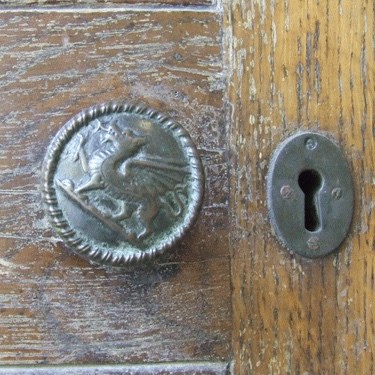
The Memorial Arch
The Memorial Arch is located in Deiniol Road in Bangor, and was completed in 1923. Built by John Laing & Son Ltd (Carlisle) under contract for £8,078, additional work brought the cost towards £15,000. Its first floor is lined with oak panels inscribed with the names of more than 8,500 soldiers, sailors and airmen who died in World War I. A Grade II listed building, it was recently restored following an appeal for funds.

 Newly built behind the memorial is Pontio. Split over six levels, Pontio is Bangor University’s brand new arts and innovation centre. The building is home to two theatres, a cinema, and a wide range of facilities for students, including a new home for the Students’ Union and numerous learning and teaching spaces.
Newly built behind the memorial is Pontio. Split over six levels, Pontio is Bangor University’s brand new arts and innovation centre. The building is home to two theatres, a cinema, and a wide range of facilities for students, including a new home for the Students’ Union and numerous learning and teaching spaces.
Types of Rock
Sedimentary rocks are formed from particles of sand, shells, pebbles, and other fragments of material. Together, all these particles are called sediment. Gradually, the sediment accumulates in layers and over a long period of time hardens into rock. Generally, sedimentary rock is fairly soft and may break apart or crumble easily. You can often see sand, pebbles, or stones in the rock, and it is usually the only type that contains fossils. Examples of this rock type include conglomerate and limestone.
Metamorphic rocks are formed under the surface of the earth from the metamorphosis (change) that occurs due to intense heat and pressure (squeezing). The rocks that result from these processes often have ribbonlike layers and may have shiny crystals, formed by minerals growing slowly over time, on their surface. Examples of this rock type include gneiss and marble.
Igneous rocks are formed when magma (molten rock deep within the earth) cools and hardens. Sometimes the magma cools inside the earth, and other times it erupts onto the surface from volcanoes (in this case, it is called lava). When lava cools very quickly, no crystals form and the rock looks shiny and glasslike. Sometimes gas bubbles are trapped in the rock during the cooling process, leaving tiny holes and spaces in the rock. Examples of this rock type include basalt and obsidian.
Surface Discolouration
Over time, stones used for building can become discoloured. The three main reasons for this are biological soiling, particle soiling and staining. Stone can become biologically stained when organisms such as algae, lichen and bacteria begin to grow on, and in the stone. Particle soiling occurs when pollution, fumes etc accumulate on the stone, discolouring the surface. Finally, staining occurs when darker minerals present in the rock gradually reach the surface.
 Specialist cleaning methods, such as sandblasting, can be used to clean building stones. However some cleaning methods do more harm than good, by disfiguring the underlying stone. Some cleaning methods can make the problem worse and increasing future discolouration by making the stone more susceptible to rain, pollution and dirt.
Specialist cleaning methods, such as sandblasting, can be used to clean building stones. However some cleaning methods do more harm than good, by disfiguring the underlying stone. Some cleaning methods can make the problem worse and increasing future discolouration by making the stone more susceptible to rain, pollution and dirt.
Logging your Find
In order to log your find, please send a message to my profile answering the below questions. There is no information about the stone around the Memorial Arch, so you may need to do some research to answer these questions, the answers to which are freely available on the internet.
In addition to the below questions, optionally upload a picture of yourself or your GPS with the arch. You can log your find immediately, but please send the answers within 24 hours. I will respond to your email as soon as I can. Logs where incomplete answers have been given, or where an email has not been received, may be deleted.
- Describe how the stone looks and feels.
- What type of rock (Igneous, Sedimetary or Metamorphic) is used?
- Can you see any evidence of how the rock was formed?
- What is the name of the stone used (e.g. granite, sandstone, slate, limestone...)?
- Can you see any surface discolouration on the surface of the rock, and if so, what type do you think it is?
